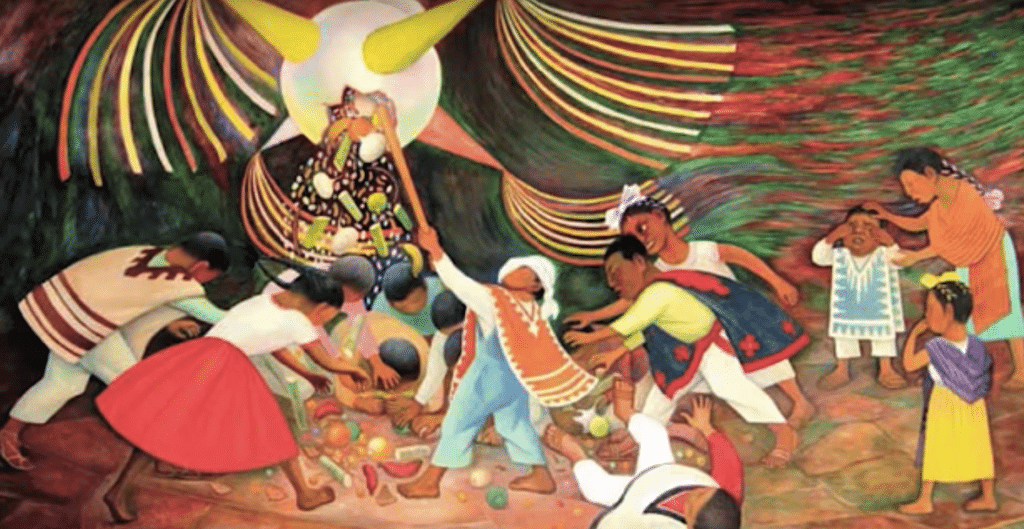Winter Celebrations in Mexico
Winter Celebrations in Mexico are one of the most anticipated celebrations of the year and are strongly influenced by the Catholic religion. They include candle-lit processions, elaborate nativity scenes, Spanish Christmas carols, dancing, fireworks, and lots of family get-togethers.
While traditions like Christmas trees and Santa Claus have found a place in Mexican festivities, Winter Celebrations in Mexico are firmly rooted in Spanish and indigenous culture.
When Catholicism arrived in Mexico through colonialism during the sixteenth century, Spanish priests brought with them many Christian holidays, including Christmas.
Over the centuries, these traditions influenced the indigenous culture, creating a unique Christmas experience that you won’t find anywhere else in the world.
Specific Dates
- 12 December: Day of the Virgin of Guadalupe (Dia de la Virgin de Guadalupe)
- 16-24 December: Las Posadas
- 24 December: Christmas Eve (Nochebuena)
- 25 December: Christmas Day (Navidad)
- 28 December: Day of the Sainted Innocents (Día de los Santos Inocentes)
- 6 January: Three Kings Day (Día de Los Tres Reyes Magos)
- 2 February: Candlemas (La Candelaria)

Traditional Posadas
From December 16th to Christmas Eve, children often perform the ‘Posada’ processions or Posadas. Posada is Spanish for Inn or Lodging. There are nine Posadas. These celebrate the part of the Christmas story where Joseph and Mary looked for somewhere to stay. For the Posadas, the outside of houses is decorated with evergreens, moss, and paper lanterns.
Nochebuena
Christmas Eve is known as ‘Noche Buena’ and is a family day. People often take part in the final Posada and then in the evening have the main Christmas meal. Popular dishes for the main Christmas meal include Pozole (a thick soup made with hominy, chicken or pork and chilies with is topped with greens), roast turkey, roast pork, tamales, bacalao (salt cod), romeritos (a green vegetable that’s cooked in a mole sauce with potatoes and shrimps) and there are normally salads served as side dishes such as Ensalada Nochebuena (Christmas Eve salad). For dessert, buñuelos are very popular, they are fried pastries sprinkled with sugar and cinnamon or hot sugar syrup. Buñuelos come in two shapes flat and round/ball! To drink there might be Ponche (a warm Christmas punch made with fruit) and Rompope (a drink similar to eggnog which often has rum added to it!).
The Infamous “Guadalupe Reyes” Marathon
Locals commonly refer to the Winter Celebrations in Mexico starting on December 12 and lasting until January 6 as “Guadalupe-Reyes”, as the Virgin of Guadalupe is celebrated on December 12 and then January 6 is Three Kings Day. Sneaky adults even came up with the “Guadalupe-Reyes Marathon”, which basically means to get your drink on every single day during this period!

Volunteering During Winter Celebrations
Winter Celebrations in Mexico are the perfect time to volunteer if you want to experience the local culture and immerse yourself in a variety of local traditions. Winter Celebrations in Mexico aren’t a one-time event like Christmas Day, but rather a full month of celebrations, marked with plenty of food, drink, and of course, piñatas!
Before You Go!
There is more to Playa del Carmen than meets the eye. Did you know that many children living in Mexico are not able to go to high school because they are charged a fee – it is not free!
While 12 years of education in Mexico is compulsory, the average number of years of education is only 9. Students who want to go on to high school need to pay for an entrance exam, school fees, transportation, and uniform costs. We believe in public education. It is not a perfect system in any country, but we believe that all children should have access to 12 years of education.
The good news is it costs less than $2 USD per day to keep a student in high school.
If you are anything like us, you will agree that so much of why we love Playa del Carmen has to do with the amazing locals. So why not do something for the community in return?
Take action, start a recurring donation now
